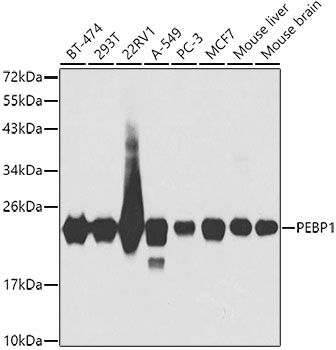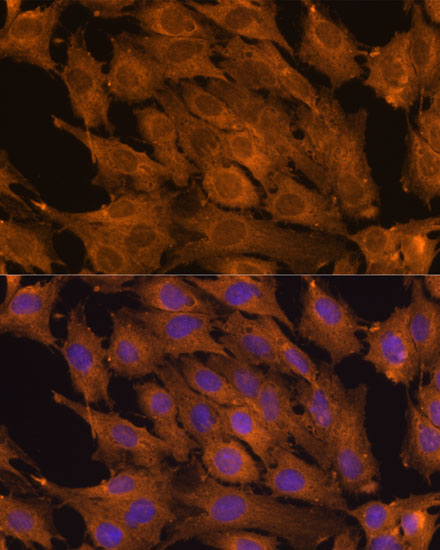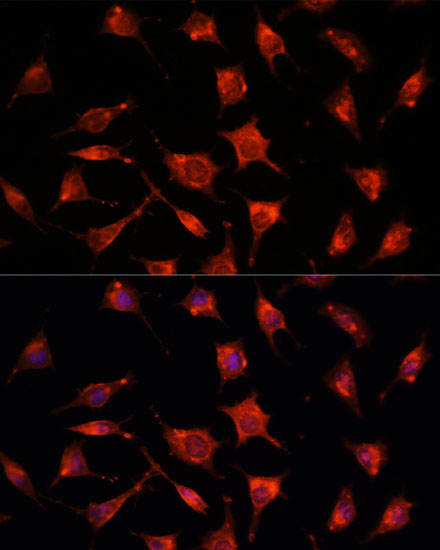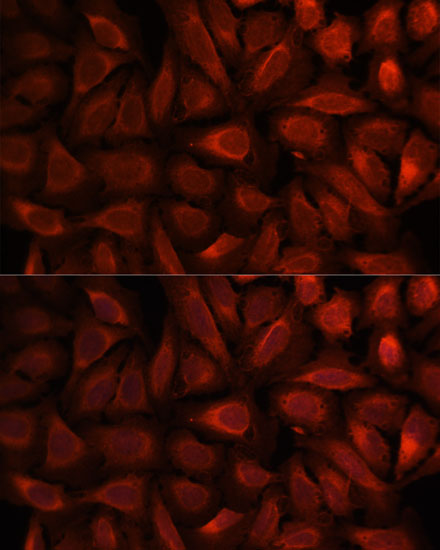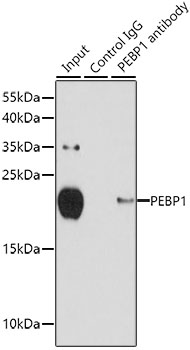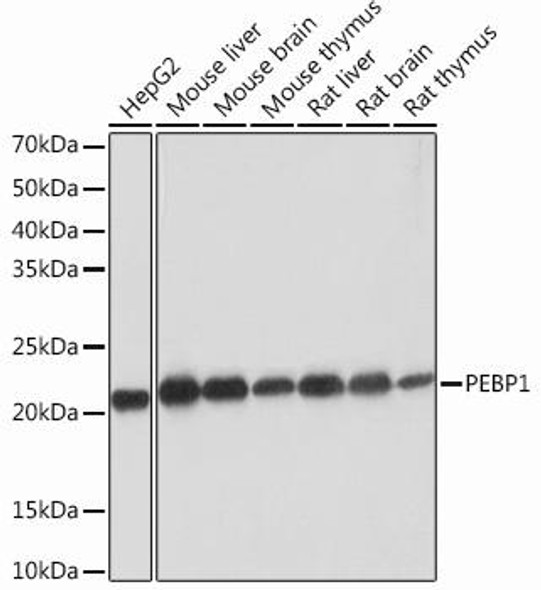Anti-PEBP1 Antibody (CAB0578)
- SKU:
- CAB0578
- Product type:
- Antibody
- Reactivity:
- Human
- Mouse
- Rat
- Host Species:
- Rabbit
- Isotype:
- IgG
- Antibody Type:
- Polyclonal Antibody
- Research Area:
- Cell Biology
Frequently bought together:
Description
| Antibody Name: | Anti-PEBP1 Antibody |
| Antibody SKU: | CAB0578 |
| Antibody Size: | 20uL, 50uL, 100uL |
| Application: | WB IF IP |
| Reactivity: | Human, Mouse, Rat |
| Host Species: | Rabbit |
| Immunogen: | Recombinant fusion protein containing a sequence corresponding to amino acids 1-187 of human PEBP1 (NP_002558.1). |
| Application: | WB IF IP |
| Recommended Dilution: | WB 1:500 - 1:2000 IF 1:50 - 1:200 IP 1:20 - 1:50 |
| Reactivity: | Human, Mouse, Rat |
| Positive Samples: | BT-474, 293T, 22Rv1, A-549, PC-3, MCF7, Mouse liver, Mouse brain |
| Immunogen: | Recombinant fusion protein containing a sequence corresponding to amino acids 1-187 of human PEBP1 (NP_002558.1). |
| Purification Method: | Affinity purification |
| Storage Buffer: | Store at -20°C. Avoid freeze / thaw cycles. Buffer: PBS with 0.02% sodium azide, 50% glycerol, pH7.3. |
| Isotype: | IgG |
| Sequence: | MPVD LSKW SGPL SLQE VDEQ PQHP LHVT YAGA AVDE LGKV LTPT QVKN RPTS ISWD GLDS GKLY TLVL TDPD APSR KDPK YREW HHFL VVNM KGND ISSG TVLS DYVG SGPP KGTG LHRY VWLV YEQD RPLK CDEP ILSN RSGD HRGK FKVA SFRK KYEL RAPV AGTC YQAE WDDY VPKL YEQL SGK |
| Gene ID: | 5037 |
| Uniprot: | P30086 |
| Cellular Location: | Cytoplasm |
| Calculated MW: | 21kDa |
| Observed MW: | 22kDa |
| Synonyms: | PEBP1, HCNP, HCNPpp, HEL-210, HEL-S-34, HEL-S-96, PBP, PEBP, PEBP-1, RKIP |
| Background: | This gene encodes a member of the phosphatidylethanolamine-binding family of proteins and has been shown to modulate multiple signaling pathways, including the MAP kinase (MAPK), NF-kappa B, and glycogen synthase kinase-3 (GSK-3) signaling pathways. The encoded protein can be further processed to form a smaller cleavage product, hippocampal cholinergic neurostimulating peptide (HCNP), which may be involved in neural development. This gene has been implicated in numerous human cancers and may act as a metastasis suppressor gene. Multiple pseudogenes of this gene have been identified in the genome. |
| UniProt Protein Function: | RKIP: a metastasis suppressor that regulates extracellular matrix remodeling and tumor survival. Binds to and inhibits Raf-1. Phosphorylation by classic and atypical but not novel PKC isoforms dissociates this complex, relieving inhibition of the Raf/MAP kinase signaling cascade. Binds ATP, opioids and phosphatidylethanolamine. Has lower affinity for phosphatidylinositol and phosphatidylcholine. Serine protease inhibitor which inhibits thrombin, neuropsin and chymotrypsin but not trypsin, tissue type plasminogen activator and elastase Inhibits the kinase activity of RAF1 by inhibiting its activation and by dissociating the RAF1/MEK complex and acting as a competitive inhibitor of MEK phosphorylation. Cleaved into hippocampal cholinergic neurostimulating peptide (HCMP) that appears to be involved in the function of the presynaptic cholinergic neurons of the central nervous system. HCNP increases the production of choline acetyltransferase but not acetylcholinesterase. Expressed in brain. Increased expression in aged senescence-accelerated mice. |
| UniProt Protein Details: | Protein type:Lipid-binding; Protein kinase, regulatory subunit Chromosomal Location of Human Ortholog: 12q24.23 Cellular Component: cytosol; nucleus Molecular Function:enzyme binding; phosphatidylethanolamine binding; protein binding; protein kinase binding Biological Process: MAPKKK cascade |
| NCBI Summary: | This gene encodes a member of the phosphatidylethanolamine-binding family of proteins and has been shown to modulate multiple signaling pathways, including the MAP kinase (MAPK), NF-kappa B, and glycogen synthase kinase-3 (GSK-3) signaling pathways. The encoded protein can be further processed to form a smaller cleavage product, hippocampal cholinergic neurostimulating peptide (HCNP), which may be involved in neural development. This gene has been implicated in numerous human cancers and may act as a metastasis suppressor gene. Multiple pseudogenes of this gene have been identified in the genome. [provided by RefSeq, Jul 2015] |
| UniProt Code: | P30086 |
| NCBI GenInfo Identifier: | 1352726 |
| NCBI Gene ID: | 5037 |
| NCBI Accession: | P30086.3 |
| UniProt Secondary Accession: | P30086,B2R4S1, |
| UniProt Related Accession: | P30086 |
| Molecular Weight: | 21,057 Da |
| NCBI Full Name: | Phosphatidylethanolamine-binding protein 1 |
| NCBI Synonym Full Names: | phosphatidylethanolamine binding protein 1 |
| NCBI Official Symbol: | PEBP1 |
| NCBI Official Synonym Symbols: | PBP; HCNP; PEBP; RKIP; HCNPpp; PEBP-1; HEL-210; HEL-S-34; HEL-S-96 |
| NCBI Protein Information: | phosphatidylethanolamine-binding protein 1 |
| UniProt Protein Name: | Phosphatidylethanolamine-binding protein 1 |
| UniProt Synonym Protein Names: | HCNPpp; Neuropolypeptide h3; Prostatic-binding protein; Raf kinase inhibitor protein; RKIP |
| Protein Family: | Phosphatidylethanolamine-binding protein |
| UniProt Gene Name: | PEBP1 |
| UniProt Entry Name: | PEBP1_HUMAN |


